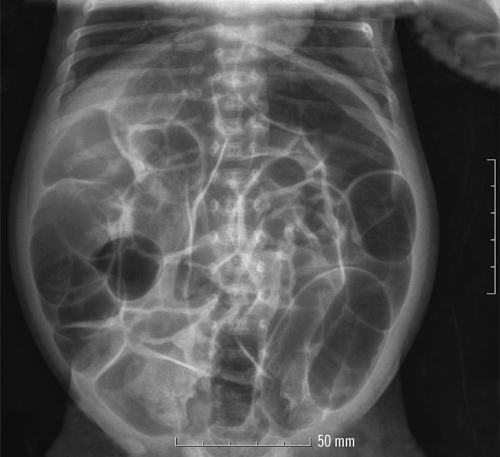Ann Lab Med.
2012 Jul;32(4):312-315. 10.3343/alm.2012.32.4.312.
Identification of SLC26A3 Mutations in a Korean Patient with Congenital Chloride Diarrhea
- Affiliations
-
- 1Department of Pediatrics, Yeungnam University College of Medicine, Daegu, Korea.
- 2Department of Laboratory Medicine and Genetics, Samsung Medical Center, Sungkyunkwan University School of Medicine, Seoul, Korea. changski@skku.edu
- KMID: 1380094
- DOI: http://doi.org/10.3343/alm.2012.32.4.312
Abstract
- Congenital chloride diarrhea (CLD) is an autosomal recessive disorder with the hallmark of persistent watery Cl(-)-rich diarrhea from birth. Mutations in the solute carrier family 26, member 3 (SLC26A3) gene, which encodes a coupled Cl-/HCO3- exchanger in the ileum and colon, are known to cause CLD. Although there are a few reports of CLD patients in Korea, none of these had been confirmed by genetic analysis. Here, we describe the case of a Korean infant with clinical features of CLD. Using direct sequencing analysis, we identified 2 sequence variants: a missense variant of unknown significance (c.525G>C; p.Arg175 Ser) and a splicing mutation (c.2063-1G>T) in the SLC26A3 gene; these had been inherited from the father and mother, respectively. Whilst CLD is rare, its main symptom, diarrhea, is very common in infants. Hence, the diagnosis of CLD can prove difficult. Mutational analysis of the SLC26A3 gene should be considered as a viable method to confirm a diagnosis of CLD in Korean infants with persistent diarrhea.
Keyword
MeSH Terms
-
Asian Continental Ancestry Group/*genetics
Chloride-Bicarbonate Antiporters/*genetics
DNA Mutational Analysis
Diarrhea/*congenital/diagnosis/genetics/radiography
Heterozygote
Humans
Infant
Male
Metabolism, Inborn Errors/*diagnosis/genetics/radiography
Mutation
Mutation, Missense
RNA Splicing
Republic of Korea
Ultrasonography, Prenatal
Figure
Cited by 1 articles
-
Congenital Chloride Diarrhea in Dizygotic Twins
Kyung Ah Seo, Na Mi Lee, Gwang Jun Kim, Sin Weon Yun, Soo Ahn Chae, In Seok Lim, Eung Sang Choi, Byoung Hoon Yoo
Pediatr Gastroenterol Hepatol Nutr. 2013;16(3):195-199. doi: 10.5223/pghn.2013.16.3.195.
Reference
-
1. Holmberg C. Congenital chloride diarrhoea. Clin Gastroenterol. 1986. 15:583–602.
Article2. Höglund P, Haila S, Socha J, Tomaszewski L, Saarialho-Kere U, Karjalainen-Lindsberg ML, et al. Mutations of the down-regulated in adenoma (DRA) gene cause congenital chloride diarrhoea. Nat Genet. 1996. 14:316–319.
Article3. Lee YD, Lee HJ, Moon HR. Congenital chloridorrhea in Korean infants. J Korean Med Sci. 1988. 3:123–129.
Article4. Yoon SK, Kim EY, Moon KR, Park SK. A case of congenital chloride diarrhea in premature infant. J Korean Pediatr Soc. 2003. 46:308–311.5. Darrow D. Congenital alkalosis with diarrhea. J Pediatr. 1945. 26:519–532.
Article6. Wedenoja S, Pekansaari E, Höglund P, Mäkelä S, Holmberg C, Kere J. Update on SLC26A3 mutations in congenital chloride diarrhea. Hum Mutat. 2011. 32:715–722.
Article7. Höglund P, Auranen M, Socha J, Popinska K, Nazer H, Rajaram U, et al. Genetic background of congenital chloride diarrhea in high-incidence populations: Finland, Poland, and Saudi Arabia and Kuwait. Am J Hum Genet. 1998. 63:760–768.
Article8. Moseley RH, Höglund P, Wu GD, Silberg DG, Haila S, de la Chapelle A, et al. Downregulated in adenoma gene encodes a chloride transporter defective in congenital chloride diarrhea. Am J Physiol. 1999. 276:G185–G192.9. Kirkinen P, Jouppila P. Prenatal ultrasonic findings in congenital chloride diarrhoea. Prenat Diagn. 1984. 4:457–461.
Article10. Ozen H, Tanriöğer N. Congenital chloride diarrhea in a Turkish boy. Turk J Pediatr. 1996. 38:235–238.11. Wedenoja S, Höglund P, Holmberg C. Review article: the clinical management of congenital chloride diarrhoea. Aliment Pharmacol Ther. 2010. 31:477–485.
Article12. Holmberg C. Electrolyte economy and its hormonal regulation in congenital chloride diarrhea. Pediatr Res. 1978. 12:82–86.
Article13. Mäkelä S, Kere J, Holmberg C, Höglund P. SLC26A3 mutations in congenital chloride diarrhea. Hum Mutat. 2002. 20:425–438.
Article
- Full Text Links
- Actions
-
Cited
- CITED
-
- Close
- Share
- Similar articles
-
- Novel Mutation of SLC26A3 Gene Observed in Congenital Chloride Diarrhea
- Oral Proton Pump Inhibitor for Treatment of Congenital Chloride Diarrhea
- A Case of Congenital Chloride Diarrhea in Premature Infant
- Development of Crohn’s Disease in a Child With SLC26A3-related Congenital Chloride Diarrhea: Report of the First Case in East Asia and a Novel Missense Variant
- Congenital Chloride Diarrhea in Dizygotic Twins



